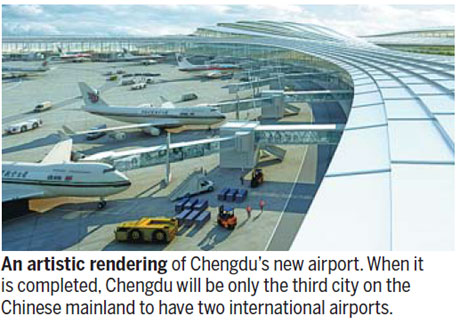New Silk Road boosts Chengdu's opening-up

As the starting point of the South Silk Road which predates the ancient Silk Road, Chengdu used to be an important trade hub connecting China to South and Central Asia.
Today the city is connected to a broader area by the new Silk Road Economic Belt and 21st Maritime Silk Road via intercontinental railways and international air routes. The cargo transported on the new Silk Roads no longer consists of silk, tea or lacquer, but mainly high-tech products such as computer chips, laptops and iPads.
In June, two Land Rover vehicles were brought from Europe to Chengdu through the Chengdu-Europe route of the China Railway Express.
China-Europe express trains are expected to import more than 1,000 finished automobiles from Europe to Chengdu in the latter half of this year, according to Chengdu Customs.
In line with the Belt and Road Initiative, the Chengdu-Europe express rail service began operation on April 23, 2013, linking Chengdu with Lodz, Poland. By June 20, the service had run 226 journeys.
The Chengdu-Europe route is the fastest and most frequently used direct freight service from China to Europe. A one-way trip takes only 10 and a half days, according to Chen Zhongwei, director of Chengdu Port and Logistics Office.
"The express rail (service) gives Chengdu an advantage over eastern coastal cities when it come to trading with Europe, because it is faster than transporting goods by sea," he said.
The Chengdu-Europe route was extended in April this year to Kutno, another city in central Poland, which enables Chengdu to further link to Nuremberg in Germany, and Tilburg in the Netherlands, Chen said.
Under the "Chengdu-Europe Plus" strategy, the express rail will be connected to more logistics hubs in Europe, including France, Belgium, Russia and Turkey. In China, it is expanding to cities including Shanghai, Shenzhen, Xiamen and Kunming. The express rail service is expected to run 400 journeys this year and 1,000 journeys next year.
The city is currently upgrading its domestic railway network and, by 2020, it will be possible to travel between Chengdu and Chongqing and other nearby cities within an hour; major cities such as Xi'an, Kunming, Guiyang and Wuhan within four hours; and to the Yangtze River Delta, Pearl River Delta and Bohai Rim area within eight hours.
The city is also building itself into a world-class aviation hub. Construction began on a new airport - Chengdu Tianfu International Airport - on May 27 in Jianyang, about 50 kilometers from downtown Chengdu. With an investment of 71.86 billion yuan ($11.7 billion), the airport will be completed in 2019 and go into operation in 2020.
This will make Chengdu the third city on the Chinese mainland to have two international airports, after Beijing and Shanghai.
The first phase will have the capacity to handle 320,000 flights, 40 million passengers and 700,000 metric tons of cargo annually by 2025.
The long-term target is to have an annual capacity of 90 million passengers and two million tons of cargo.
Pan Gangjun, general manager of the Sichuan Province Airport Group Co, said the new airport will operate international passenger routes and most international cargo routes in the future, while the existing airport, about 16 km from downtown Chengdu, will be limited to domestic flights and some international cargo routes.
Through the intercity railway, highways and subway linked to the new airport, passengers can easily reach downtown Chengdu and its neighboring cities.
The new airport is expected to increase capacity and further boost the city's appeal to investors.
"The new airport will strengthen Chengdu's position as western China's transportation hub, and accelerate the economic development of the city," said Deng Ling, a professor of economics at Sichuan University. Deng said the new airport will also enhance the opening-up of Chengdu and Sichuan province, and help to promote the development of the Silk Road Economic Belt and Yangtze River Economic Belt.
Sheng Yi, deputy director of the Sichuan Academy of Social Sciences, said the new airport will help the city attract talent and resources, enhance international exchanges and boost industrial development. The long-term target is to have an annual capacity of 90 million passengers and two million tons of cargo.
With rapid economic development and more frequent international exchanges, Chengdu has seen a sharp increase in its air traffic in recent years. Chengdu Shuangliu International Airport is the fourth-busiest airport on the Chinese mainland. It handled 42 million passengers last year, an increase of 12.1 percent year-on-year, according to statistics released by the Civil Aviation Administration of China.
The city already has 89 international routes, the largest number in China's central and western region. It is planning to open direct routes to international cities including New York, Sydney, Rome and Johannesburg this year, according to the Sichuan Port and Logistics Office.
(China Daily 07/23/2016 page25)














